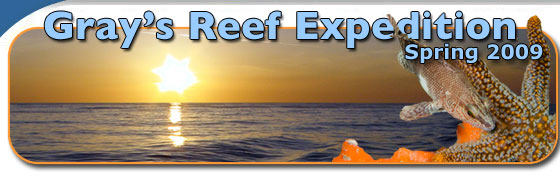Error processing SSI file
|
Gray's Reef Expedition
Log Day 1: June 8, 2009
 |
| Everyone working to set up in the wetlab. (Photo: Mike Mullenix)
|
At last we are finished planning and we can start DOING! Today we finally had the full team on board. All the gear was loaded and readied for our mission and the lines were tossed off the pier! After months and months of planning, departing the dock is always a thrill. We have a terrific team of professionals on board and a very ambitious set of missions to accomplish, so we’re all eager to get underway.
Unfortunately, we didn’t get very far! The ship is installing a new compressor system to support diving operations. Installing a complex piece of equipment like a NITROX (gas mixture of nitrogen and oxygen) compressor takes a lot of time and skill. Due to a host of factors, it still was not complete when we left the dock. In order to give the technicians more time to complete the installation, we decided to simply run down the Cooper River, just a short distance into Charleston Harbor, and anchor the ship. We needed to install a scientific instrument on the hull of the ship, which would require SCUBA divers. The instrument, a fish finding transducer, is going to be used by Laura Kracker to collect data on fish distribution in the water column. Doing the installation in the harbor would allow “Nitrox Bob” the chance to spend more time on the ship (he would be returned to Charleston by small boat at the end of the day).
 |
| Greg McFall and Ben Nolan discuss transducer mount while Laura Kracker and Greg Walker look on. (Photo: NOAA/Sarah Fangman) |
Greg McFall and Abigail Higgins completed the first dive and encountered difficult conditions – the current at our location was so strong that they were unable to stay in position to secure the transducer. Divemaster Melody Ovard made the decision the dive operations would be postponed until slack water (meaning when the currents weren’t running so quickly). So after a few hours, another attempt was made. This time, Greg McFall was diving with the ship’s navigation officer Kevin Adams. The team was able to make good progress on the installation, however, the job could not be completed before the currents picked up again. As a result, we were stuck waiting until the next slack water which, frustratingly, wasn’t until the following morning. On the positive side, that meant that we were able to all get a good night’s sleep as we were anchored in the protected waters of the Charleston Harbor!
 |
| Kevin Adams enters the water in Charleston Harbor. (Photo: NOAA/Sarah Fangman) |
Throughout the day, the science team busily prepared gear and equipment for the upcoming missions. CJ Carroll worked with Mike Mullenix and Jeff Hart to set up two of the tanks that will be holding the fish we plan to catch for tagging. Peter Auster and Laura Kracker prepared the Didson sonar and camera sled, which will be used on board the Skidaway Institute’s vessel, R/V Explorer. Greg McFall and Jeff Godfrey assisted with installing the NITROX compressor. Laurie Bauer met with Dave Grenda, Mike Mullenix and Jeff Hart to plan their marine debris surveys and Peter Auster met with his team (Victoria Price, Ian Le Clair Dave Grenda and Jeff Godfrey) to go over their dive survey protocols.
Finally, the project leads (Laurie Bauer, Matt Kendall, Peter Auster and Laura Kracker) met with Sarah Fangman to discuss the plan of the day for our first full day in the sanctuary. Because each of the projects being conducted on this mission have different requirements for where, when and how they need to be accomplished, it takes a lot of coordination and flexibility to come up with the daily plan. After much discussion and deliberation, a plan was born. Now if we can just get to the sanctuary and get started, we’ll feel a lot more productive! |








